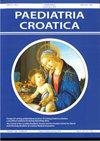唐氏综合症儿童的睡眠表型——睡眠结构改变和睡眠呼吸障碍
Q4 Medicine
引用次数: 0
摘要
这项研究的目的是评估唐氏综合症儿童的睡眠结构和睡眠呼吸。这项研究是通过使用夜间视频多导睡眠图(V-PSG)对唐氏综合症儿童和普通人群中年龄匹配的儿童进行的。多导睡眠图参数分析显示,与普通人群中年龄和成熟度匹配的健康儿童的正常值相比,唐氏综合征儿童的睡眠潜伏期显著缩短(p=0.007),总睡眠时间显著缩短(p=0.004),睡眠效率显著降低(p=0.010),NREM1睡眠期(p=0.0002)较少,NREM3睡眠期(p=0.034)较少,快速眼动睡眠较少(p=0.034),有利于更多的NREM2期,但不显著(p=0.069),睡眠开始后醒着的时间更长(p=0.0002)。唐氏综合征儿童每小时阻塞性睡眠呼吸暂停和低通气显著增加(阻塞性睡眠暂停和低呼吸指数较高)(p=0.008),但每小时中枢性睡眠呼吸停止较少(中枢性呼吸暂停指数较低)(p=0.041),这导致唐氏综合征儿童的总呼吸暂停低通气指数(p=0.762)显著降低。这两组患者的平均和最长呼吸暂停时间没有显著差异。唐氏综合征儿童的平均血氧饱和度和最低点血氧饱和度明显较低(分别为p=0.008和p=0.001)。总之,通过提高父母和医疗保健提供者对唐氏综合症儿童睡眠障碍的认识,并在这些儿童的随访中引入早期常规V-PSG,可以预防唐氏综合症患儿的大多数呼吸道并发症。本文章由计算机程序翻译,如有差异,请以英文原文为准。
Sleep phenotype in children with Down syndrome – altered sleep architecture and sleep-disordered breathing
The aim of the study was to assess sleep architecture and breathing in sleep in children with Down syndrome. The study was conducted by using overnight video-polysomnography (V-PSG) in children with Down syndrome and age-matched children from the general population. Analysis of polysomnographic parameters revealed that compared to the norms of healthy ageand maturitymatched children from the general population, children with Down syndrome had significantly shorter sleep latency (p=0.007), shorter total sleep time (p=0.004), lower sleep efficiency (p=0.010), less NREM1 sleep phase (p=0.0002), less NREM3 sleep phase (p=0.034), less REM sleep (p=0.034) in favour of more NREM2 phase but not significantly (p=0.069), and spent more time awake after sleep onset (p=0.0002). Children with Down syndrome had significantly more obstructive sleep apnoeas and hypopnoeas per hour (higher obstructive sleep apnoeas and hypopnoeas index) (p=0.008), but less central sleep apnoea per hour (lower central apnoeas index) (p=0.041), which led to the nonsignificantly lower total apnoea-hypopnoea index (p=0.762) in children with Down syndrome. The mean and longest apnoea duration did not differ significantly between these two groups. Children with Down syndrome had a significantly lower mean and nadir oxygen saturation (p=0.008 and p=0.001, respectively). In conclusion, the majority of respiratory complications in children with Down syndrome can be prevented by raising awareness of sleep disturbances in children with Down syndrome among their parents and health care providers and by introducing early routine V-PSG in the follow up of these children.
求助全文
通过发布文献求助,成功后即可免费获取论文全文。
去求助
来源期刊

Paediatria Croatica
医学-小儿科
CiteScore
0.20
自引率
0.00%
发文量
0
审稿时长
6-12 weeks
期刊介绍:
In the inaugural 1956 issue of the journal, the editor Dr Feđa Fischer Sartorius outlined the journal''s vision and objectives saying that the journal will publish original papers on the development, pathology, and health care of children from the prenatal period to their final biological, emotional and social maturity. The journal continues this vision by publishing original research articles, clinical and laboratory observations, case reports and reviews of medical progress in pediatrics and child health.
 求助内容:
求助内容: 应助结果提醒方式:
应助结果提醒方式:


